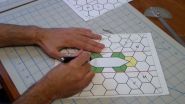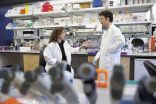(Press-News.org) Advances in treatment for human immunodeficiency virus (HIV) have made it possible for people with HIV to survive much longer. As they age, however, many experience impaired thinking, memory loss, mood swings and other evidence of impaired mental function.
To stop these changes, scientists have to learn what is causing them. One possibility researchers are considering is that long-term infections with other pathogens, common in HIV-positive patients, are affecting the brain. But a new study has eliminated one of their prime suspects: the hepatitis C virus, which infects about one in every three HIV-positive patients in the United States.
The research, conducted by a team that includes scientists at Washington University School of Medicine in St. Louis, appeared Dec. 10 in Neurology.
"Hepatitis C infection has serious long-term side effects, such as damage to the liver, but our research indicates that it does not affect the brain," said lead author David Clifford, MD, of Washington University.
The research was conducted as part of the CNS HIV Anti-retroviral Therapy Effects (CHARTER) study, a multicenter collaborative that is examining the long-term neurological effects of HIV infection.
Hepatitis C most commonly infects illicit-drug users who share needles used to inject the drugs. Drug abuse can harm the brain, making it difficult to determine whether hepatitis C or problems caused by drug use contribute to brain impairment in patients with both HIV and hepatitis C.
To answer this question, Clifford and his colleagues studied 1,582 HIV patients, 408 of whom were also infected with hepatitis C. Each patient received a detailed neuropsychological exam devised by Clifford and other CHARTER researchers to detect signs of HIV-associated mental deficits.
The exam takes two to 2 1/2 hours, and includes written examinations taken by the patient and physical exams given by medical professionals. Patients are tested for their ability to express themselves, to make decisions, to learn and retain new information using multiple types of memory, and to move the body and control muscles.
"In all, we looked at seven domains of mental function," said Clifford, who is the Melba and Forest Seay Professor of Clinical Neuropharmacology in Neurology. "We studied their overall performance and looked at each domain individually and found no evidence that the group with hepatitis C performed worse."
According to Clifford, this was particularly impressive because the participants in the group with hepatitis C were older, had less education and had lower scores on tests of reading, comprehension, spelling and math.
With hepatitis C eliminated, Clifford and his colleagues are turning their attention to the immune responses triggered by HIV in the brain and the bowel during the initial stages of infection. He and others believe these early responses, which include bursts of inflammation, lead to chronic inflammation that adversely affects the brain.
"If a hepatitis C infection gets to the point where it damages liver function, the resulting inflammation might well contribute to mental impairment," Clifford said. "Beyond that, though, it doesn't seem to be an active collaborator in the harm HIV does to the brain."
INFORMATION:
CHARTER is supported by National Institutes of Health (NIH) grant numbers N01MH22005, HHSN271201000036C, and HHSN271201000030C.
Clifford DB, Vaida F, Kao Y-T, Franklin DR, Letendre SL, Collier AC, Marra CM, Gelman BB, McArthur JC, Morgello S, Simpson DM, Grant I, Heaton RK. Absence of neurocognitive effect of hepatitis C infection in HIV-coinfected people. Neurology. Dec. 10, 2014
Washington University School of Medicine's 2,100 employed and volunteer faculty physicians also are the medical staff of Barnes-Jewish and St. Louis Children's hospitals. The School of Medicine is one of the leading medical research, teaching and patient-care institutions in the nation, currently ranked sixth in the nation by U.S. News & World Report. Through its affiliations with Barnes-Jewish and St. Louis Children's hospitals, the School of Medicine is linked to BJC HealthCare.
Lincoln, Neb., Dec. 11, 2104 -- A University of Nebraska-Lincoln researcher has contributed to discoveries about bird evolution as part of a new study that sequenced the complete genomes of 45 avian species.
Published Dec. 11 in the journal Science, the study found that avian genomes -- the complete archive of genetic material present in cells -- have exhibited surprisingly slow rates of evolution when compared with their mammalian counterparts.
Jay Storz, a Susan J. Rosowski Associate Professor of Biological Sciences, led a research group that assisted the study by examining ...
The fruits and vegetables provided at school deliver an important dietary boost to low income adolescents, according to Meghan Longacre, PhD and Madeline Dalton, PhD of Dartmouth Hitchcock's Norris Cotton Cancer Center and The Hood Center for Children and Families. In a study released in Preventive Medicine, Longacre and Dalton found that fruit and vegetable intake was higher among low income adolescents on days when they consumed meals at school compared to days when low income adolescent were not in school. The opposite was true for high income adolescents who consumed ...
PITTSBURGH--The 2013 Boston Marathon bombing motivated mass expressions of fear, solidarity, and sympathy toward Bostonians on social media networks around the world. In a recently released study, researchers at the University of Pittsburgh and Cornell University analyzed emotional reactions on Twitter in the hours and weeks following the attack.
The study is the first large-scale analysis of fear and social-support reactions from geographically distant communities following a terrorist attack. The findings show the extent to which communities outside of Boston expressed ...
Origami is capable of turning a simple sheet of paper into a pretty paper crane, but the principles behind the paper-folding art can also be applied to making a microfluidic device for a blood test, or for storing a satellite's solar panel in a rocket's cargo bay.
A team of University of Pennsylvania researchers is turning kirigami, a related art form that allows the paper to be cut, into a technique that can be applied equally to structures on those vastly divergent length scales.
In a new study, the researchers lay out the rules for folding and cutting a hexagonal ...
A CEO's natural sunny disposition can have an impact on the way the market reacts to announcements of company earnings, according to research from the University of British Columbia's Sauder School of Business.
The study shows that leaders' inclinations to express themselves with optimism carries over into their tone when disclosing company performance - a tendency that can create an uptick in stock price.
"Ours is the first study to look at the effect of how managers naturally convey themselves," says Sauder Assistant Professor Jenny Zhang, who co-authored the paper. ...
Senescent cells have a bad-guy reputation when it comes to aging. While cellular senescence - a process whereby cells permanently lose the ability to divide when they are stressed - suppresses cancer by halting the growth of premalignant cells, it is also suspected of driving the aging process. Senescent cells, which accumulate over time, release a continual cascade of inflammatory cytokines, chemokines, growth factors and proteases. It is a process that sets up the surrounding tissue for a host of maladies including arthritis, atherosclerosis and late life cancer. But ...
The ascetic and moralizing movements that spawned the world's major religious traditions--Buddhism, Islam, Judaism, Hinduism, and Christianity--all arose around the same time in three different regions, and researchers reporting in the Cell Press journal Current Biology on December 11 have now devised a statistical model based on history and human psychology that helps to explain why. The emergence of world religions, they say, was triggered by the rising standards of living in the great civilizations of Eurasia.
"One implication is that world religions and secular spiritualities ...
EMBARGOED for release Thursday, Dec. 11, 2014, at 12 p.m. ET
HOUSTON - (Dec. 11, 2014) - The ancient Japanese art of origami is based on the idea that nearly any design - a crane, an insect, a samurai warrior - can be made by taking the same blank sheet of paper and folding it in different ways.
The human body faces a similar problem. The genome inside every cell of the body is identical, but the body needs each cell to be different -an immune cell fights off infection; a cone cell helps the eye detect light; the heart's myocytes must beat endlessly.
Appearing online ...
Clinical trials to test the new drugs in patients should begin as early as 2015.
Existing drugs target faulty versions of a protein called BRAF which drives about half of all melanomas, but while initially very effective, the cancers almost always become resistant to treatment within a year.
The new drugs - called panRAF inhibitors - could be effective in patients with melanoma who have developed resistance to BRAF inhibitors.
The new study was funded by the Wellcome Trust and Cancer Research UK, and jointly led by scientists at The Institute of Cancer Research, ...
Scientists at the University of Southampton have found that the precise shape of an antibody makes a big difference to how it can stimulate the body's immune system to fight cancer, paving the way for much more effective treatments.
The latest types of treatment for cancer are designed to switch on the immune system, allowing the patient's own immune cells to attack and kill cancerous cells, when normally the immune cells would lie dormant.
In a study, funded by Cancer Research UK and published in the journal Cancer Cell, the Southampton team have found that a particular ...



